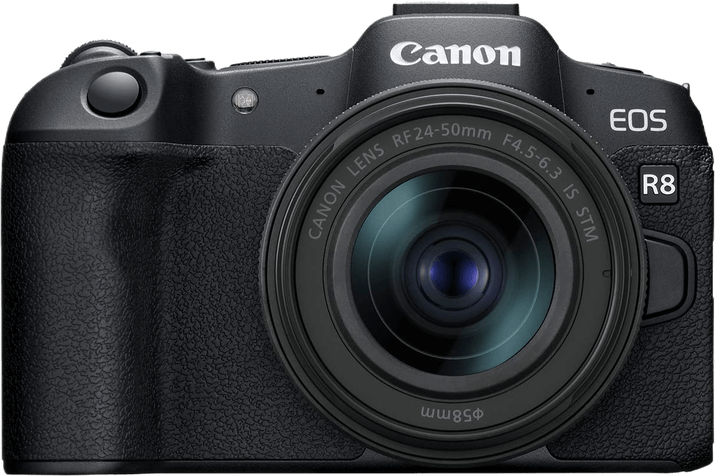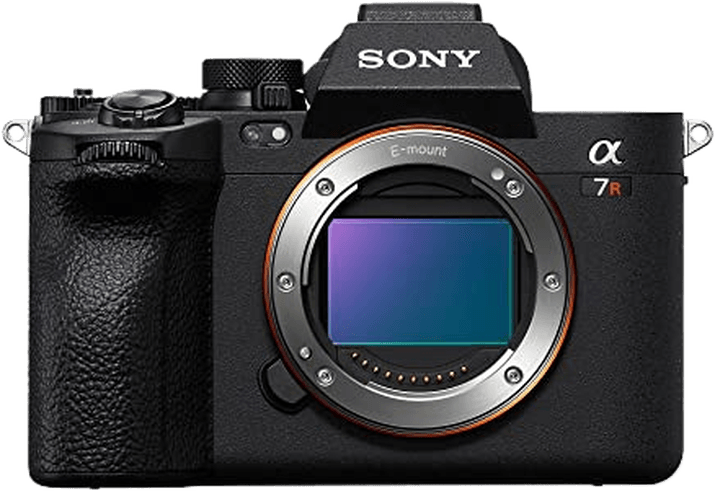Canon EOS R8 vs Sony a7R V Comparison
Canon EOS R8

Sony a7R V

The Sony a7R V outperforms the Canon EOS R8 with a score of 85/100 compared to 76/100. Both cameras are mirrorless and were released in 2022 and 2023, respectively. Although the Canon EOS R8 is lighter at 461g and has a smaller size of 133 x 86 x 70mm, the Sony a7R V offers better performance with its higher score.
The Sony a7R V’s advantage lies in its superior performance, despite its larger size of 131 x 97 x 82mm and heavier weight of 723g. However, the Canon EOS R8 is more budget-friendly with a launch price of $1499, compared to the Sony a7R V’s $3999 price tag.
To sum it up, the Sony a7R V is the better camera in terms of performance, but the Canon EOS R8 is a more affordable and lighter option.
Canon EOS R8 vs Sony a7R V Overview and Optics
The Sony a7R V outperforms the Canon EOS R8 in optics with a score of 85/100 compared to the R8’s 77/100. Both cameras share common specifications such as a CMOS sensor, full frame sensor size, and a DXOMARK score of 94 for the sensor. However, there are significant differences between the two cameras that contribute to the higher score for the Sony a7R V.
The Sony a7R V has an impressive 61 megapixels, far surpassing the Canon EOS R8’s 24 megapixels. This results in higher resolution images with more detail for the a7R V. In addition, the Sony a7R V features image stabilization, which the Canon EOS R8 lacks. This provides steadier shots and improved image quality, particularly in low light conditions or when using longer focal length lenses.
On the other hand, the Canon EOS R8 has a faster shooting speed of 40 frames per second compared to the Sony a7R V’s 10 frames per second. This can be beneficial for capturing fast-moving subjects or action shots. The R8 also uses the Canon RF lens mount, which offers a wide range of high-quality lenses.
Despite the higher shooting speed and Canon RF lens mount, the Sony a7R V still takes the lead due to its significantly higher megapixel count and image stabilization feature. These factors contribute to the Sony a7R V’s superior optics score and make it a better choice for photographers seeking higher resolution images and improved image quality.
Canon EOS R8 vs Sony a7R V Video Performance
The Sony a7R V outperforms the Canon EOS R8 in video capabilities with a perfect score of 100/100, while the Canon EOS R8 trails behind with a score of 91/100. Both cameras share common features such as time-lapse functionality built-in, making them suitable for capturing stunning time-lapse videos.
The Sony a7R V excels with its maximum video resolution of 8K, providing incredibly detailed and high-quality footage with video dimensions of 7680 x 4320. This feature sets the Sony a7R V apart from its competitor, the Canon EOS R8, which has a max video resolution of 4K and video dimensions of 3840 x 2160. However, it is important to note that the Canon EOS R8 offers a higher maximum video frame rate of 180fps, compared to the Sony a7R V’s 120fps. This advantage allows the Canon EOS R8 to produce smoother slow-motion footage.
Despite the lower video resolution, the Canon EOS R8 still delivers high-quality 4K videos, which may be sufficient for many users’ needs. Additionally, its higher frame rate offers more flexibility for videographers interested in capturing fast-action scenes or creating slow-motion effects.
Both cameras possess strong video capabilities, with the Sony a7R V taking the lead in terms of video resolution and the Canon EOS R8 offering a higher frame rate. Users should consider their specific requirements and preferences when choosing between these two cameras. The Sony a7R V is the better choice for those who prioritize ultra-high-resolution footage, while the Canon EOS R8 may be more suitable for those who value smooth slow-motion capture.
Canon EOS R8 vs Sony a7R V Features and Benefits
The Sony a7R V emerges as the winner in the features comparison with a score of 87/100, while the Canon EOS R8 trails closely with a score of 85/100. Both cameras share several specifications, making them quite similar in terms of features.
The Canon EOS R8 and Sony a7R V both have touchscreens, flip screens, Wi-Fi, and Bluetooth capabilities. Neither camera includes GPS functionality. These shared specs contribute to the cameras’ overall appeal and functionality.
The Sony a7R V outperforms the Canon EOS R8 in screen size and resolution. The Sony camera has a larger 3.2-inch screen compared to the Canon’s 3-inch screen. Additionally, the Sony a7R V boasts a higher resolution of 2,100,000 dots, providing clearer and more detailed images on the screen. This advantage makes the Sony a7R V a better choice for photographers who prioritize screen quality and size.
The Canon EOS R8, despite its lower feature score, still offers impressive specifications. Its 3-inch touchscreen and 1,620,000-dot resolution provide good image quality and ease of use. While it does not surpass the Sony a7R V in these aspects, the Canon EOS R8 remains a solid option for photographers seeking a high-quality camera with useful features.
Both cameras offer a range of features that cater to different photography needs. The Sony a7R V stands out with its larger screen and higher resolution, while the Canon EOS R8 remains a strong contender with its own set of impressive specifications. Ultimately, the choice between these two cameras depends on individual preferences and requirements.
Canon EOS R8 vs Sony a7R V Storage and Battery
The Sony a7R V emerges as the winner in the storage and battery comparison with a score of 73/100, while the Canon EOS R8 scores 35/100. Both cameras have USB charging capabilities and accept SD, SDHC, and SDXC memory cards. However, the Sony a7R V stands out with a longer battery life of 530 shots, compared to the Canon EOS R8’s 370 shots. Additionally, the Sony a7R V supports CFexpress Type A cards and offers two memory card slots, providing more storage flexibility.
The Canon EOS R8, although trailing, still offers a decent battery life and compatibility with UHS-I and II SD cards. Despite its lower score, it remains a capable camera for various photography needs.
Taking into account the storage and battery capabilities, the Sony a7R V provides superior performance in this category. Its longer battery life and additional memory card slot make it a more versatile choice for photographers who require extended shooting sessions and ample storage options.
Canon EOS R8 vs Sony a7R V – Our Verdict
Are you still undecided about which camera is right for you? Have a look at these popular comparisons that feature the Canon EOS R8 or the Sony a7R V:

